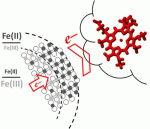Citation:

摘要:
Present and emerging biotechnological applications for iron (oxyhydr)oxide nanomaterials depend on their interaction with microorganisms, as do their toxicity, transport, and fate in biological and environmental systems. However, mass or electron transfer along key molecular pathways at microbe–nanomaterial interfaces is extremely difficult to quantify because of system complexity. Inspired by Fe(II)-oxidizing microbes widespread in nature, we isolate and characterize one such pathway by examining the oxidation of Fe3–xTixO4 (magnetite-titanomagnetite) nanoparticles by the bacterial electron transfer enzyme MtoA, a decaheme c-type cytochrome. Oxidation by MtoA was studied as a function of the thermodynamic driving force for electron transfer by controlling the Ti(IV) doping content (x), which tunes the solid-state Fe(II)/Fe(III) ratio built into the nanoparticles. A higher Fe(II)/Fe(III) ratio appears to systematically increase the electron transfer kinetics to the cytochrome. In situ X-ray diffraction indicated that, during oxidation, the spinel ferrite lattice remains intact while structural Fe(II) is progressively depleted. Surface and atomic site specific Fe L2,3-edge X-ray magnetic circular dichroism indicated that MtoA directly accesses magnetically ordered B-sublattice Fe(II) at the interface. This study provides the first quantitative insights into an isolated molecular pathway for biotransformation of iron (oxyhydr)oxide nanomaterials, and more generally, it also illustrates new techniques for probing these pathways in detail, featuring use of tailored nanoparticles, purified metalloenzyme, and synchrotron X-ray absorption spectroscopies.